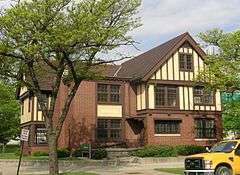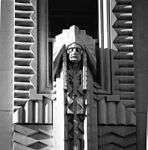Marcus Burrowes
Marcus R. Burrowes (1874 – 1953) was a notable Detroit architect. He served one year in the position of president of the Michigan Society of Architects and was a fellow of the American Institute of Architects (AIA). He was widely known in southeast Michigan, especially during the second and third decades of the twentieth century, for his recreation of English Revival style buildings.
Biography
Burrowes was born in Tonawanda, N.Y., near Buffalo. Burrowes attended the Denver Art Academy, where he attended lectures and received instruction by architects of note, as well as serving an apprenticeship to a leading architectural firm in Denver. In the 1890s, Burrowes work took him to Canada, where he was employed in the chief architects office of the Dominion at Ottawa, specializing in post office buildings. From Canada, he crossed the Detroit River to Detroit, a place suitable for an entrepreneurial architect like Burrowes.
Initially, Burrowes worked in the offices of Albert Kahn. In 1907, he joined the firm of Stratton and Baldwin for two years, which put him into contact with leading figures in the Arts and Crafts movement in Detroit, including Kahn, William B. Stratton, Frank C. Baldwin, and George Booth. Through Stratton's connections with Mary Chase Perry Stratton of Pewabic Pottery, Burrowes gained exposure to this important Detroit-based firm as well.
However, deciding his future was to be in independent practice, Burrowes formed the firm of Burrowes and Wells with Dalton R. Wells. By 1914, Burrowes was operating under his own name. In 1920 he joined with Frank Eurich, who had received training in the architecture program from Cornell University. Together, Burrowes and Eurich designed many homes in Grosse Pointe and Detroit, as well as several libraries and municipal buildings.
During his lifetime, Burrowes was recognized by his fellow architects. He served as president of the Detroit Chapter of the American Institute of Architects in 1916 and 1917; vice-president of the Detroit Chapter in 1923, and secretary from 1911 to 1915. He served as president of the Michigan Society of Architects in 1923 and 1924. In 1940, he was made a Fellow of the American Institute of Architects and became Emeritus in 1952. He was a member of the Episcopal Church and the Detroit Athletic Club.
Burrowes died at the age of 79 at his home in London, Ontario, which he had retired to eight months previous. His obituary in the Detroit Free Press in 1953, stated how "he designed more than 1,000 structures in and near Detroit during his long career."
Selected commissions
| Name | City | State/Country | Year Designed | Built | Other Information | Image | |
|---|---|---|---|---|---|---|---|
| Hiram Walker and Sons, Customs Office Building | Walkerville | Ontario, Canada | 1910 | (Burrowes and Wells) | |||
| Cranbrook Service Quarters, Garages | Bloomfield Hills | Michigan | 1911 | ||||
| H.R. Dingwell Home | Walkerville | Ontario, Canada | 1912 | Devonshire Road | |||
| Hiram Walker Home | Walkerville | Ontario, Canada | 1912 | Devonshire Road | |||
| Cranbrook Greek Theatre | Bloomfield Hills | Michigan | 1915-1916 | ||||
| Warren Booth Home | Bloomfield Hills | Michigan | Lone Pine Road | ||||
| Grace Booth Wallace Home | |||||||
| Brookside School | Bloomfield Hills | Michigan | Evergreen Road(with Henry Scripps Booth) | ||||
| W.G. Morley House | Bloomfield Hills | Michigan | Lone Pine Road | ||||
| David A. Brown House | Detroit | Michigan | East Boston Boulevard | ||||
| C.B. Tuttle House | Detroit | Michigan | Hamilton Drive | ||||
| Victor F. Dewey House | Detroit | Michigan | Hamilton Drive | ||||
| A.L. McCarthy House | Detroit | Michigan | Hamilton Drive | ||||
| William Locke House | Detroit | Michigan | Hamilton Drive | ||||
| Percy A. Barnard House | Detroit | Michigan | Fairway Drive | ||||
| Warren Booth Home | Detroit | Michigan | 1922 | 2950 Iroquois | |||
| Henry L. Pierson, Sr. House | Detroit | Michigan | 1915 | 2530 Iroquois | |||
| Mrs. Walter Jennings' Home | Detroit | Michigan | 2455 Iroquois | ||||
| Herman Strasburg House | Detroit | Michigan | 1915 | 5415 Cass |  | ||
| 2243 Iroquois | Detroit | Michigan | 1917 | ||||
| Newton Annis Home | Detroit | Michigan | 2168 Burns | ||||
| 1432 Burns | Detroit | Michigan | |||||
| Miss Jeannette McMillan Liggett Home | Detroit | Michigan | 2501 Burns | ||||
| S. Kemp Pittman, Sr. Home | Detroit | Michigan | 1912 | 1782 Seminole | |||
| 2454 Seminole | Detroit | Michigan | |||||
| Paul Gray House | Detroit | Michigan | 1910 | 1710 Seminole | |||
| Ralph Harmon Booth Home | Grosse Pointe | Michigan | 1924 | 315 Washington | |||
| Berrien C. Eaton Home | Grosse Pointe | Michigan | Bishop Road | ||||
| Edward S. Caulkins Home | Grosse Pointe | Michigan | Hendrie Lane | ||||
| H. Robert Stoepel Home | Grosse Pointe | Michigan | |||||
| L.T. Bulkley Home | Grosse Pointe | Michigan | Edgemont Park | ||||
| Charles B. Crouse Home, Cadieux and Maumee | Grosse Pointe | Michigan | |||||
| Edward G. Burlage Home | Grosse Pointe | Michigan | Harvard Road | ||||
| Henry T. Cole Home | Grosse Pointe | Michigan | Lakeland | ||||
| Addition to Palmer Sherman House | Farmington | Michigan | Farmington Road | ||||
| Burbrook | Farmington | Michigan | 1924 | residence of Marcus R. Burrowes, 24300 Locust Drive |  Burbrook, Farmington Hills, Michigan | ||
| David Gray House | Farmington Hills | Michigan | in present-day Heritage Park |  Gray-Spicer House, Farmington Hills, Michigan | |||
| Windy Hill | Farmington | Michigan | Kirby White House, Eleven Mile Road | ||||
| Cottage, Biddestone Woods estate | Farmington | Michigan | 1937 | ||||
| C.W. Hubbell | Milford | Michigan | 1923 | 1937 | |||
| Wayne County Training School | Northville Township | Michigan | 1923 | ||||
- Libraries
- Gabriel Richard Library, Stoepel and Grand River, Detroit
- Redford Village Hall (Redford Library), Six Mile and Grand River, 1928
- Duffield Branch of the Detroit Public Library, West Grand Boulevard and Lunedin
- Francis Parkman Branch of the Detroit Public Library, 1726 Oakman, Blvd, Detroit, 1931
- McGregor Library, Woodward Avenue, Highland Park (Local associated architects. Building designed by Tilton & Githens of New York)
- Schools and Civic Complexes
- Wayne County Training School, near Northville
- Barber School, Highland Park
- Highland Park Athletic Fieldhouse, Highland Park
- Grosse Pointe High School, Grosse Pointe Farms
- Grosse Pointe Cottage School, Grosse Pointe
- Grosse Pointe Hunt Club Clubhouse, Grosse Pointe
- Grosse Pointe Golf Clubhouse, Grosse Pointe
- Peoples' State Bank, Detroit
- Remodeling of Greenmeade, Eight Mile Road, Livonia
- Grand Lawn Cemetery entrance, Grand River just east of Telegraph Road
- Methodist Children's Village, Six Mile Road, Redford
- YMCA, Highland Park
- YWCA, Highland Park
- Grosse Pointe Municipal Building
- Springwells Town Hall, later Dearborn City Hall
- Birmingham Civic Complex, Birmingham, 1921-1922
- Starr Commonwealth, outside Albion, Michigan
Design of 11 buildings and campus landscape plan
- Newton Hall, Starr Commonwealth, 1915
- Emily Jewell Clark Building, Starr Commonwealth, 1917
- Wilcox Cottage, Starr Commonwealth
- Hillside, later Payne Family Cottage, Starr Commonwealth, 1920
- Webster Hall, Starr Commonwealth, 1934
- Inglis-Medelssohn Cottage, Starr Commonwealth
- Chapel in the Woods, Starr Commonwealth, 1949
- Breuckner Museum and Art Gallery, Starr Commonwealth, 1952
- Designs for Candler Hall, Kresge Cottage, Norton Family Cottage, Starr Commonwealth - all built after Burrowes death
References
Fox, Jean M. "Marcus Burrowes, English Revival Architect", Monograph #2, Farmington Hills Historical Commission, 1992.
Wilson, Tim Wayne County Training School
Preserve Detroit, [www.preservedetroit.com]
